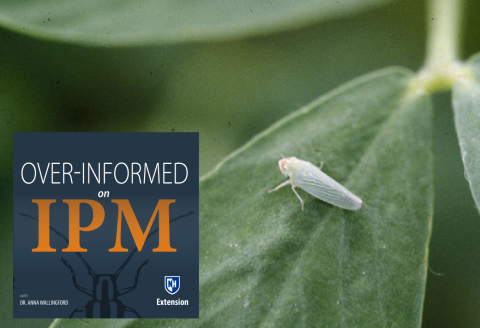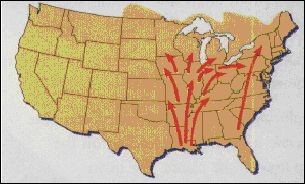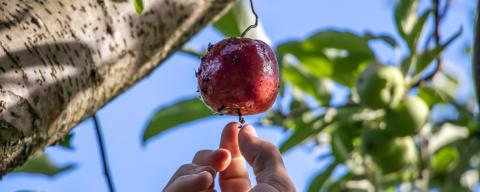Over-informed on IPM - Episode 013: Potato Leafhopper


Transcript
Even though this season has been cool and wet and delayed, potato leafhopper arrived right on time to wreak havoc on young potato plants, snap beans, strawberries and raspberries.
Overwintered adults arrive on weather patterns from the south. Adults and subsequent nymphs feed on plants and inject a toxic saliva, which causes hopperburn on plants. Beans are particularly susceptible to this – leaves turn yellow, turn under, leaf margins turn brown. You might notice a cloud of the tiny little adults jumping around when you bat at a plant. You might look a little closer and see the tiny, almost neon green nymphs darting back and forth, get this, sideways. This is a goofy and reliable way to identify potato leafhopper.
Best practices for avoiding injury to PLH is to have nice big healthy plants before they arrive. Mature plants can take a little damage without losing out on yield. Young plants can be protected with row cover until they’re old enough for life on their own. Scout plants often to detect the first signs of PLH. Careful with broad-spectrum insecticides because you might cause flare-ups of secondary pests and end up chasing the dragon. Also repeated waves of PLH migration are possible so keep scouting those young plants and act early because once you see signs of hopperburn, it may be too late to save those plants. And remember! Pesticides must be applied only as directed on the label to be in compliance with the law. So read those labels!
Honestly, these guys can be pretty tough, especially if insecticides aren’t a tool in your IPM toolbox. For other potential management techniques, I spoke with someone who knows potato leafhopper really well.
Lily Calderwood, UMaine
Anna: Lily’s current position has her very busy with the needs of blueberry growers and we’ll return to this in a later episode but, in a past life, she worked on PLH attacking hops.
Lily: Potato leafhopper is definitely a migratory pest. They’re down in the South Carolina, Alabama area, then they are picked up and brought north. So it becomes a very unpredictable pest.
Anna: What’s the best advice you have for predicting when they’re coming? Have a friend in Maryland that will call you and tell you they’re coming?
Lily: Yes. No question about it…It seems to me that if we get a big rainstorm that comes up from the south, it’s likely to bring leafhoppers with it.
Anna: As an aside I’d like to point out that we a very sure that potato leafhopper does not overwinter up here and that they migrate north every year. More interesting and perhaps more controversial. There is evidence that the leafhopper progeny that establish up here don’t just die when the winter comes, but migrate back south in the winter. This may be a story for another day but the team that provided this evidence was lead by Cornell’s Elson Shields and it involved sampling insects using remote controlled aircraft. There motto was “hundreds of meters above the rest”, which still puts a smile on my face.
But I digress! Lily and I got into an interesting conversation about leafhopper behavior in hops and the major research questions of her PhD work.
Lily: When these potato leafhoppers arrive, where do they land and are there certain hop varieties that they like more than others? Could we use some sort of cover crop or trap crop in between rows that the potato leafhoppers would be more attracted to than the plants?
I found that there were certain varieties of hops that were more susceptible to potato leafhopper – or more susceptible their damage. That is because different hop varieties have a different range of the density and number or trichomes on the underside of the leaves. Those leaf hairs contain chemistry that are repelling the leafhopper.
Anna: I’m going to jump in again here to talk briefly about plant trichomes. Like Lily said, trichomes are leaf hairs. Leaves have hair! Plant species vary in the amount and types of leaf hairs they produce. Even some varieties vary – this is where a lot of effort has been put into breeding plant resistance, or plants that repell insects. There’s lots of different kinds of trichomes but they can be divided in to the kind that repel insects physically – like just making it hard for bugs to eat the leaves – or the kind that repels insects chemically. Some trichomes secrete challenging chemicals, often called secondary metabolites or secondary compounds, that make bugs like the leafhopper want to hop far away if they can, to find something a little easier to deal with. Back to Lily:
Lily: So certain varieties have more of certain compounds, others have less but there might be more individual hairs. Both the physical and chemical defense there.
Anna: How would you use this information in practice?
Lily: So hop varieties…certain hop varieties are sought after by brewers for their flavor. What the add to a beer, if its aromatics or bittering. When developing a hop variety, that flavor takes precedence and the ability to grow the crop comes second. So disease resistance, insect resistance, and just the ability to grow…but it is part of the picture. They do take these things into account. There are a few companies, and the USDA, that breed hop varieties. These days, there’s really a race to come up the with next new sexy hop variety.
It’s a really interesting plant because you have so much chemistry that can be manipulated, it can be changed to create these new varieties. There are more than 300 now.
Anna: I have a question for you that might come from a place of ignorance. I would assume that the chemicals associated with defending that plant are related to the chemicals that make up flavor components? IS there a relationship between flavor components in the cones and the leaves? Is it too rudimentary for you to say that the more flavorful or more complex those cones are, the better defended the plant is?
Lily: Yeah, we don’t have an answer to that. It’s a good question, and I did do some data crunching at one point. There was a relationship between the number of leafhoppers observed and the amount of alpha and beta acids. Alpha acids are the bittering components and the beta acids are the aromatic compounds. It’s really too much of stretch to say the leafhoppers prefer the bitter or the aromatic varieties – each variety does have a leaning towards either one – but they’re all a combination. We didn’t quite get there.
Transition
Lily: Then, in the field, I was trying to see if PLHs were more attracted to certain plants over the hops. We did find that they are more attracted to clover and legumes over hops. So they will land in clover or bean over hops, however…ok, well you say they really like alfalfa, so lets plant a bunch of alfalfa and they’ll be attracted to that so we don’t have to worry about them on hops. But it turns out there’s a lot of alfalfa fields in the north east. They need to be cut. You’ve got to cut that hay, and once you cut the hay, the leafhoppers fly right over to the hops…or to another crop like beans or raspberries, daliahs, whatever it is.
Something you could do – the leafhoppers arrive at the edge of the field and they’re on those edge plants first. You could use those as your “trap” and spray just those as they arrive. But then, with PLH you get multiple arrivals, different waves of the insect coming up from the south. You have to really keep an eye out, keep your yellow sticky traps up, and you might need to spray again.
Anna: So what have we learned here. PLH loves beans! Well I bet anyone growing beans knows this already. We see multiple waves of PLH entering susceptible crops – this is from regional and local migration. Regional migration is harder to predict but – in terms of predicting local migration - you might think about asking for a heads up from neighbors cutting hay, especially neighbors growing alfalfa. While plant breeders are always on the hunt for resistant plant varieties that also make delicious beer or the tastiest raspberries, we’re not quite there yet with PLH. Stay tuned!
That’s it for this week. Thanks to Lily Calderwood at UMaine and special thanks to Brentwood’s favorite son, Jason Lightbown who wrote and performed our theme music.
Post image couresty of Steve L. Brown, University of Georgia, Bugwood.org
Complete Show Episode List
Extension Services & Tools That Help NH Farmers Grow
Newsletters: Choose from our many newsletters for production agriculture
Receive Pest Text Alerts - Text UNHIPM to (866) 645-7010
